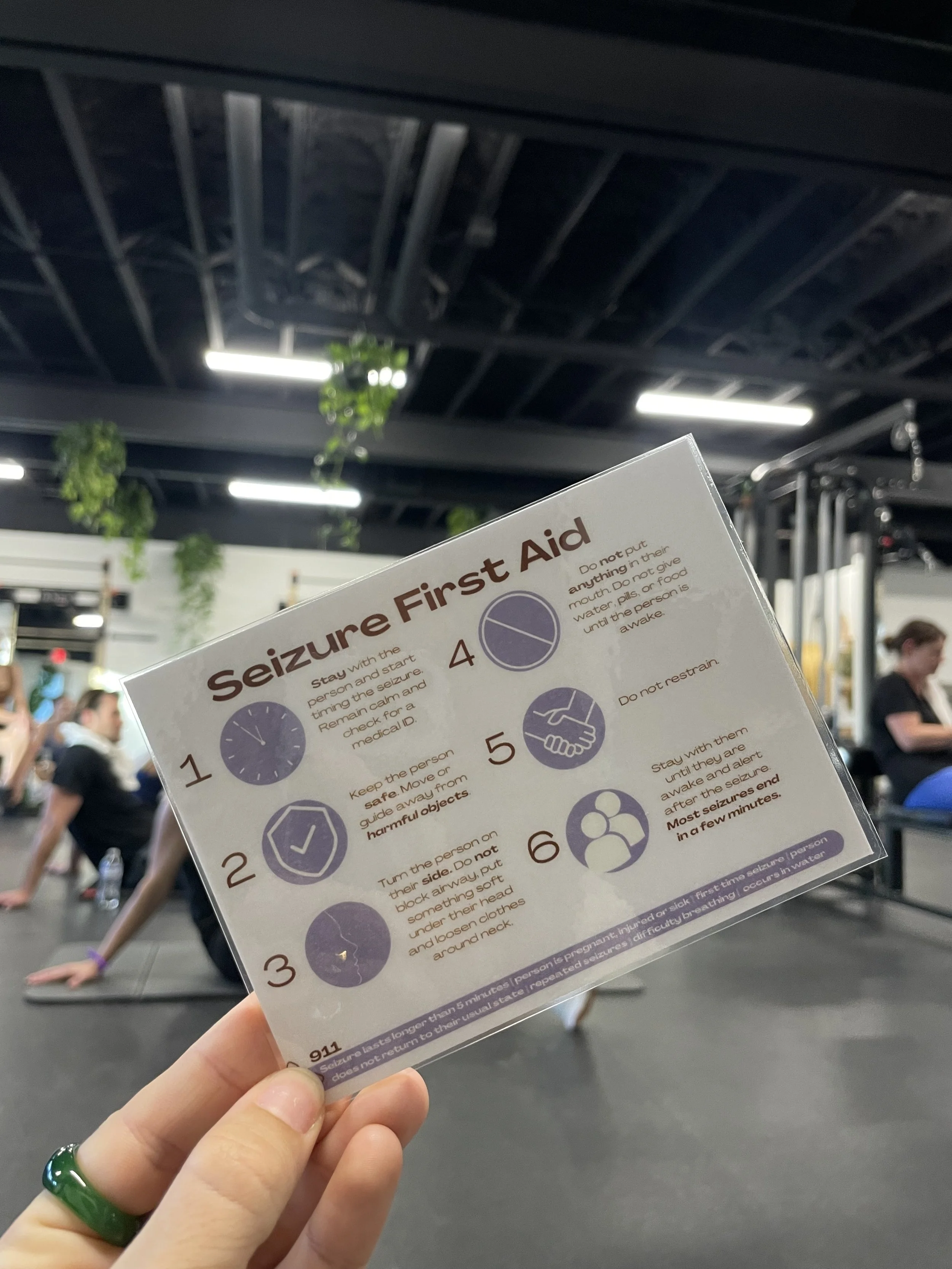How To: Seizure First Aid
“...the average seizure lasts anywhere from 30 seconds to 2 minutes, medical professionals will likely not get to the scene until after the seizure has ended. From the start of the seizure until likely the end, you are the professional. You have the opportunity to keep that individual as safe as possible. ”
I’m a numbers girl–I love to see the hard data. Statistically speaking, you have a high probability of seeing a seizure in your lifetime. One in 10 people will have a seizure in their life. One in 26 will be diagnosed with a form of epilepsy (to clarify: there are many different types of epilepsy). Teaching seizure first aid prepares us all for this scary yet common moment. There are different types of seizures which lend to different types of treatment. The seizure first aid I tend to teach most is for grand mal seizures–this presents as falling to the ground, foaming at the mouth, uncontrollable shaking, and potentially incontinence.
As a young girl, I often lived in fear that someone would see me have an episode and have no idea what to do. When I was younger and I told people of my diagnosis, I was met often with ignorant comments and jokes–not out of malintent, but out of lack of public education. If we don’t talk about what needs to be learned and changed, how will we learn and change?
So, what do I teach during seizure first aid?
Stay with the person having the seizure. Start timing the seizure and check for a medical ID.
-For some, this event could be totally normal. Checking a medical ID to see if they have epilepsy is helpful for the onlooker. It is also important to call their In Case of Emergencies (ICE) for assistance as well. Timing the seizure is helpful data. The average seizure lasts anywhere from 30 seconds to 2 minutes. If a seizure lasts over 5 minutes, call 911. This is serious cause of concern.
2. Keep the person safe. Move away from harmful objects.
-When someone is having a seizure, they aren’t in control of any of their muscles. If they are in a tight space where they have the potential to kick something with their leg or arm, move the object first. If the object is immovable (i.e. a building or heavy piece of equipment), guide the individual away quickly through moving their torso, rather than their arms or legs. We want to minimize the amount of injury during the seizure.
3. Turn the person on their side. Put something soft under their head and loosen any clothes around their neck, such as a tie or top button.
-This is paramount! Since the person seizing is in control of zero muscles, their throats are also compromised. If they are having a seizure on their back or stomach, their airways are at a much higher risk for choking or suffocating. By putting someone on their side, this allows all excess saliva to fall out of the mouth thanks to gravity, rather than fall back.
4. Do not put anything in the mouth.
-Nothing, nothing, NOTHING goes in the mouth! Someone experiencing a grand mal seizure is experiencing unnatural muscle movement. It is a danger both to the onlooker and the person seizing to put something in the mouth. The common misconception that one can swallow their tongue during a seizure is false. Any medication or water that goes in the mouth heightens the risk of choking. Any fingers or objects placed in the mouth heightens the risk of injury both for the onlookers hands/fingers, but also the teeth and mouth of the individual having the seizure. No medications, no nothing until that person is fully finished seizing, awake, and alert. TIP: after a seizure, ask the individual QUESTIONS! “Where are you?”, “What day is it?”, “What’s your name?”. This will indicate to you if the person is truly alert and aware after their seizure.
5. Do not restrain.
-Seeing a grand mal seizure is naturally scary, I understand. Although we want it to stop as soon as possible, we can’t. The more the person is restrained, the higher the risk of injury. The muscles are convulsing at an incredibly strong rate–if restrained, this heightens the risk of potential muscle tears, dislocations, and physical pain post-seizure.
6. Stay with them until they are awake and alert. Most seizures end in a few minutes.
-Just because someone’s eyes are open, does not mean they are awake or alert! The postictal state–the post-seizure state– looks different for everyone. Patience and grace need to be at the forefront for the onlooker. This person’s brain is turning back on again–it’s doing a full reset. Stay near and ask questions to ensure they are returning to a normal state of coherence. You are doing a great job.
Lastly, I often get asked, “Do I call 911?”. You can always call 911… that’s why they’re there! Let me give you some examples of when medical professionals should certainly take the reins:
The seizure is lasting longer than 5 minutes
The person is pregnant, injured, or sick
First time seizure
Person is not returning to their usual state
Person is having repeated seizures
Difficulty breathing
Seizure occurs in water
Back to the numbers: if the average seizure lasts anywhere from 30 seconds to 2 minutes, medical professionals will likely not get to the scene until after the seizure has ended. From the start of the seizure until likely the end, you are the professional. You have the opportunity to keep that individual as safe as possible.
Thank you from the bottom of my heart for learning how to save my life, and so many others around you. Consider yourself capable for now having the tools to best be there for your neighbor.
Have a safe and seizure free day! :)
-Laura
